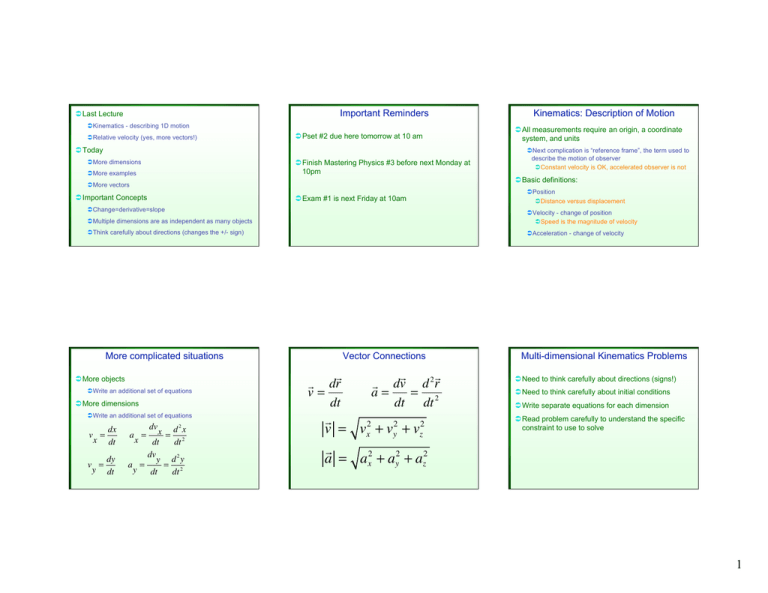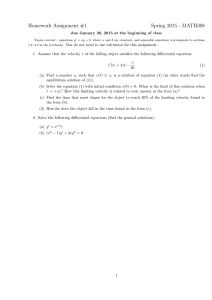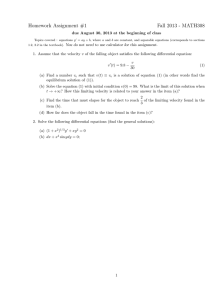Important Reminders Kinematics: Description of Motion
advertisement

Important Reminders Last Lecture Kinematics - describing 1D motion Relative velocity (yes, more vectors!) Pset #2 due here tomorrow at 10 am Today More dimensions Finish Mastering Physics #3 before next Monday at 10pm More examples Kinematics: Description of Motion All measurements require an origin, a coordinate system, and units Next complication is “reference frame”, the term used to describe the motion of observer Constant velocity is OK, accelerated observer is not Basic definitions: More vectors Important Concepts Exam #1 is next Friday at 10am Change=derivative=slope Position Distance versus displacement Multiple dimensions are as independent as many objects Velocity - change of position Speed is the magnitude of velocity Think carefully about directions (changes the +/- sign) Acceleration - change of velocity More complicated situations More objects Write an additional set of equations More dimensions Write an additional set of equations dx v = x dt dy v = y dt dv d2x a = x = 2 x dt dt dv 2 y d y a = = 2 y dt dt Vector Connections ! ! dr v= dt ! ! ! dv d 2 r a= = dt dt 2 ! v = vx2 + vy2 + vz2 ! a = ax2 + ay2 + az2 Multi-dimensional Kinematics Problems Need to think carefully about directions (signs!) Need to think carefully about initial conditions Write separate equations for each dimension Read problem carefully to understand the specific constraint to use to solve 1 Special Case of Constant Acceleration x = x0 + v0 x t + 12 ax t 2 vx = v0 x + ax t y = y0 + v0 yt + 12 ayt 2 vy = v0 y + ayt Physics Initial conditions Quadratic Equations ax + bx + c = 0 2 x= !b ± b ! 4ac 2a 2 Extra special case Super special case Trajectories with gravity near the surface of the Earth and no air resistance or other drag forces Range of a projectile near the surface of the Earth and no air resistance or other drag forces x0 = 0 y0 = 0 y final = 0 x final = Range Y v0 θ X ax = 0 v0 x = v0 cos(! ) ay = !g v0 y = v0 sin(" ) Range = v02 sin(2! ) g You should immediately forget you ever saw this formula but remember the technique used to find it. Summary Study special cases (like range of a projectile) but understand the assumptions that go into all formulas Position, velocity, and acceleration are ALL vectors and need to be manipulated using either arrows (qualitative) or components (quantitative) Directions (or signs in 1D) of position, velocity, and acceleration can all be different Important property: Such equations can have 0, 1, or 2 solutions depending on the value of b2 -4ac. Negative: 0 solutions Zero: 1 solution Positive: 2 solutions Warning: Only one of the 2 solutions may be physical! 2






